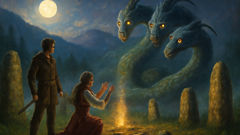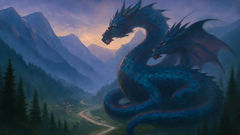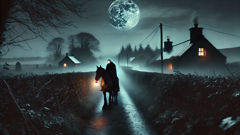Introduction
In the folds of Romania’s ancient Carpathian Mountains, where mist lingers long after dawn and forests breathe legends into every glade, there thrived a tale whispered by firelight and river’s edge. Villages such as Sânziene clung to their valleys, sheltered by steep crags and sprawling green, their people bound to the land and to the old stories that shaped them. In this land, the wild felt near—wolves sang beneath the full moon, bears roamed the shadowed woods, and something older still seemed to watch from the highest peaks. The most revered and feared among these stories was that of the Balaur: a dragon-like creature with shimmering scales the color of river stones and eyes that glimmered like coals. Ancient and mighty, the Balaur was said to have many heads—sometimes three, sometimes seven, sometimes more—each with jaws strong enough to crush oaks and teeth sharper than the sickle moon. Yet for all its fearsome power, the Balaur was not merely a beast of chaos. Folklore insisted it was a guardian, its lair hidden deep within the Sacred Vale, a narrow pass high above the valley, veiled in perpetual mist. Travelers who strayed too close vanished, and even the bravest hunters refused to tempt fate by venturing near. Only on certain nights—when the stars burned with unnatural brightness and the wind seemed to carry voices—did villagers glimpse a silhouette coiling across the moonlit ridges, and they would cross themselves, whispering prayers both old and new. Children learned to respect the mountain’s silence. Elders taught the boundaries of safe ground, and stories grew around the fire: of heroes who sought the dragon’s treasure, of maidens protected by its might, of secret bargains and ancient wrongs. And so, for generations, the Balaur endured in the heart of every villager’s imagination—a force of nature and fate, both fearsome and, in some mysterious way, essential. Yet every legend has its moment when the line between myth and truth blurs, and a new chapter must be written by those bold—or desperate—enough to seek answers. This is the tale of one such moment, when a shepherd’s courage and a maiden’s secret intertwined with the fate of a village and the will of a dragon.
I. The Shepherd and the Shadow on the Ridge
The summer of Andrei’s seventeenth year arrived with early wildflowers and storms that rolled off the peaks. He was a shepherd, as his father and grandfather had been, tasked with leading the village flock to the high meadows each morning. The Sacred Vale loomed above, always veiled by a shroud of cloud, as if guarding its secrets even from the sun. Andrei was not fearless—no one in Sânziene was—but he was curious and loyal to his land. One morning, while leading his flock along a stream that bordered the forbidden vale, he noticed hoof prints—too large for any goat or sheep, and pressed deep into the mud. There were claw marks, too, and a strange, charred scent on the wind. The old tales stirred in his mind. That night, as he sat by his small fire beneath an ancient beech, he heard the low rumble of thunder—or so he thought—until the sound resolved into something deeper, a growling echo that vibrated through the earth. He looked up and saw, silhouetted against the moon, an impossible shape: serpentine bodies, wings that stretched like banners, and many heads rising and falling like the peaks themselves. Fear rooted him to the spot. Yet even as panic urged him to run, a different urge held him—wonder, and a strange, aching sense that something was wrong. The next day, the village woke to find a section of the upper pastures blackened and the stream running warm and cloudy. The elders muttered prayers and forbade anyone from approaching the Sacred Vale. But that evening, a stranger arrived: a girl no older than Andrei, cloaked in deep green, her hair woven with mountain flowers. She called herself Ilinca, and her eyes held a knowledge far older than her years. She spoke little, but Andrei caught her more than once gazing up toward the veiled pass. Rumors spread. Some said she was an orphan; others whispered she was a witch, or worse—a harbinger of the dragon itself. Andrei, drawn by her quiet strength, offered her bread and a place by his fire. Ilinca’s gratitude was soft-spoken, but her gaze lingered on his shepherd’s staff—carved with ancient runes he didn’t understand. As the nights grew wilder and storms lashed the mountains, the Balaur’s shadow became a frequent presence on the ridge. Sheep vanished, and villagers saw strange lights flickering in the high mist. Fear turned to anger. Some demanded Ilinca be driven out, blaming her for awakening the dragon. Andrei, torn between his loyalty to his people and the intuition that Ilinca was not their enemy, resolved to discover the truth. One night, he followed her as she slipped from the village toward the Sacred Vale. Hidden among the stones, he watched as she knelt beside a ring of ancient stones, chanting words in a language that made the hair on his arms stand up. The mist thickened, and in its swirling depths, the Balaur’s eyes appeared—vast and sorrowful. Instead of attacking, the beast listened. Ilinca pleaded—not for herself, but for the valley. "It’s not your rage that brings destruction," she whispered, "but something else—an old wound, a broken promise." Andrei stepped into the clearing, heart hammering. The Balaur’s gaze turned to him, weighing his courage, his intent. In that moment, Andrei saw not a monster but a guardian in torment. The dragon spoke—not in words, but in images and memories flooding his mind: betrayal, a sacred trust violated by those who once worshipped here, and the burden of keeping a secret that could save or doom the valley. Andrei realized that only by facing the truth behind the legend could he hope to save his home—and perhaps heal the dragon’s ancient wound.

II. The Bargain Beneath the Mountains
Ilinca’s voice trembled but did not falter as she faced the ancient creature. The Balaur’s heads regarded her and Andrei with curiosity, suspicion, and sorrow. The air in the Sacred Vale seemed to pulse with old power—a mingling of earth and memory. "Why do you disturb my slumber?" The words did not come from any mouth but reverberated in their minds. Andrei’s vision swam with images: a golden-haired priestess in white robes, villagers bearing offerings to a stone altar, a time when dragon and human lived in wary harmony. He saw betrayal—greedy hands taking what was forbidden, a bloodied knife, a pact broken by pride. Ilinca’s hands shook as she reached for her satchel, retrieving an object wrapped in faded cloth. It was a shard of carved bone, etched with runes matching those on Andrei’s staff. "I am of the old blood," she said softly. "My mother served as keeper of the Vale, but the line was broken. I seek to mend it, to renew the oath." The Balaur’s heads lowered, exhaling plumes of vapor that stung their eyes. "The wound festers," the dragon whispered in their thoughts. "Each generation forgets a little more. My rage grows because I am forgotten, not because I wish to harm." Andrei’s fear faded into empathy. He saw how the sacred place had been desecrated—stones toppled, offerings ended, and villagers now feared what they once revered. The valley’s harmony had fractured. Ilinca knelt before the Balaur, pressing the bone shard to the earth. "We offer ourselves to restore the bond," she said, voice quivering. "But we cannot do it alone." The dragon’s gaze flickered with hope and caution. "The path is not without peril. My power is bound to this place. To heal it, you must return what was stolen—a talisman of the first oath. It lies in the caves beneath the mountain, guarded by shadows and memories." Andrei volunteered at once, though his hands shook. Ilinca promised to remain and tend the stones, weaving spells of protection. Before he left, the Balaur gave him a single scale—heavy and iridescent, warm to the touch. "This will shield you from harm," it rumbled. "But your heart must be steady, or darkness will find you." Andrei descended into the mountain’s heart. The tunnels twisted, echoing with the drip of unseen water. Shadows thickened as he pressed on, the dragon’s scale casting a faint glow. At every turn, he was tested—not by beasts of flesh, but by visions of failure, loss, and temptation. Ghostly echoes tempted him to abandon hope, but he clung to memories of Ilinca’s bravery and the villagers’ trust. Deep in the mountain, he found a chamber carved with spirals and ancient glyphs. On a stone altar lay the talisman: a twisted circlet of gold, set with a single blue stone that pulsed with inner light. But as he reached for it, darkness coalesced—a spectral form, half-shadow, half-flame, the embodiment of old betrayal. "You are not worthy!" it hissed. Andrei steadied himself, remembering the Balaur’s gift. He held up the scale, which blazed with blinding light, driving back the shadow. "I come not for myself," he declared. "But for all who dwell here—for the promise broken and the trust that must be restored." The shadow wailed and dissolved into mist. With trembling hands, Andrei lifted the talisman and retraced his steps, guided by the scale’s glow. He emerged into dawn’s pale light, exhausted but victorious. Ilinca was waiting at the stone circle, the Balaur coiled behind her like a living mountain. Together, they presented the talisman to the dragon. The Balaur bowed its heads, eyes shining with gratitude. As Ilinca recited the old vows and Andrei laid the talisman on the altar, a wind stirred—warm and bright, dispelling the lingering mist. Flowers bloomed where none had grown for years. The dragon’s scales shimmered with renewed strength, and its roar echoed not in anger, but in joy. The Sacred Vale was healed, at least for now, but Andrei knew that legends lived on only so long as people remembered. He and Ilinca vowed to become the new guardians—not just of the valley, but of its stories, so the old wounds would never reopen.

Conclusion
In the years that followed, Sânziene flourished in ways both subtle and profound. The Sacred Vale remained shrouded in its mist, but fear no longer gripped the hearts of its people. Andrei and Ilinca became more than legend-bearers; they were living bridges between past and future, guardians of memory as much as of land. The Balaur’s presence was felt in every gentle rain, every flock’s safe return, every unexpected wildflower blooming in rocky soil. Children listened wide-eyed to stories of the dragon, but now those tales carried hope as well as awe. The villagers relearned old customs—leaving offerings at the standing stones, singing at dawn—and found that harmony with the wild brought peace to their days. Ilinca’s wisdom and Andrei’s courage shaped a new tradition, one where every voice mattered and even the oldest wounds could be healed with patience and truth. And so, the legend of the Balaur endured—not as a monster to be feared, but as a reminder that every place has its guardians, every promise its price, and that the heart of any land beats strongest when its people remember their roots and embrace their courage.













